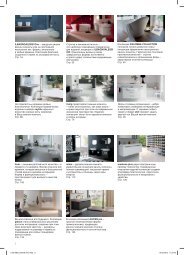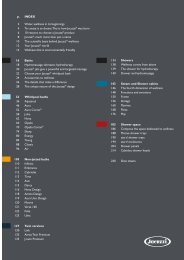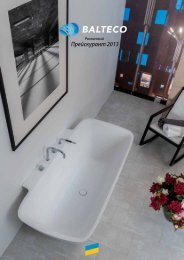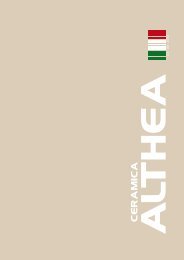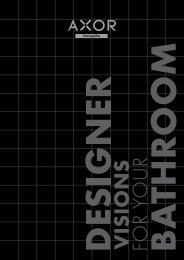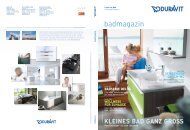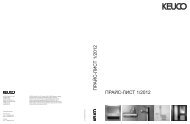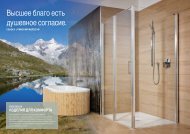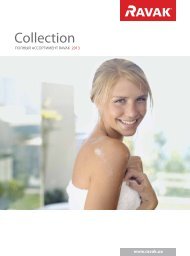You also want an ePaper? Increase the reach of your titles
YUMPU automatically turns print PDFs into web optimized ePapers that Google loves.
206<br />
Dimensional features ISO 10545/2<br />
This standard describes the test methods used to calculate the dimensional features of ceramic tiles (length, width, thickness, straightness of sides, orthogonality, planarity of the<br />
surface) and the quality of ceramic tiles.<br />
Water Absorption ISO 10545/3<br />
This standard describes the test method that determines the percentage of water that ceramic tiles can absorb under specific conditions. It is a very important test as water<br />
absorption is one of the classification parameters of ceramic tiles together with shaping.<br />
Bending strength<br />
This industry standard specifies a test method to calculate breaking strength (S) and bending strength (R) of ceramic tiles.<br />
Deep scratch resistance ISO 10545/6<br />
Abrasion resistance is the resistance of the surface to wear and tear connected with the movement of bodies, surfaces and materials that come into contact with it.<br />
Floors can be subject to different abrasive stresses: contact of shoe soles, trolley and cart wheels, dragging of furniture, ordinary and extraordinary cleaning means, etc.<br />
These abrasive stresses must never cause: removal of material from the surface alteration of the aesthetic features of the surface itself.<br />
The test is carried out on unglazed surfaces (UGL) in order to calculate the amount of material that is removed due to the action of an abrasive disk. Ceramic tiles are more resistant<br />
depending on the amount of material removed from the surface. <strong>Marca</strong> <strong>Corona</strong> full-body coloured porcelain stoneware tiles fully comply with industry standard requirements.<br />
<strong>Marca</strong> <strong>Corona</strong> full-body coloured porcelain stoneware tiles comply with industry standards.<br />
Scratch resistance ISO 10545/7<br />
Abrasion resistance is the capacity of the glaze surface to resist the wear caused by foot traffic or the abrasion caused by mechanical equipment (lift trucks, etc.). The wear action is<br />
strictly linked with the mechanical agent (rubber sole, leather sole, etc.), the material carried onto the surface (water, sand, mud, etc.) and the classified in five categories depending<br />
on the areas they are to be used in:<br />
ISO 10545/7<br />
PEI I Tiles for areas with ligth traffic and without abrasive dirt, e.g. bathrooms, bedrooms.<br />
PEI II Tiles for areas with average traffic and medium to low abrasion, e.g. studyng rooms, living rooms.<br />
PEI III Tiles for areas with higt medium to high traffic and average abrasion, e.g. foyer, kitchen in private residences.<br />
PEI IV<br />
Tiles for areas with intense traffic, e.g. restaurants, offices, shops, public offices (excluding floors under cash desks and shop counters and narrow<br />
unavoidable passageways).<br />
PEI V Tiles for areas with especially intense traffic.<br />
ISO 10545/4



